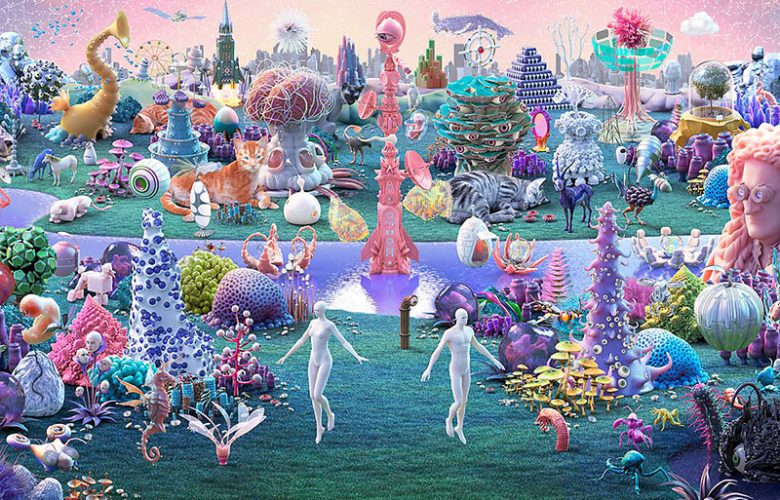How would Bosch have created his famous work The Garden of Earthly Delights in the 21st century? Would it be in digital, sound or motion format?
In 1515, Hieronymus Bosch created in Netherlands an imaginary world, full of strange elements, unreal animals, fantastic architectures, gigantic fruits and strange birds immersed in wild and disconcerting nature. He has fascinated viewers for all time. Now current artists recreate the scene, reinventing new “delicious Gardens” for the 21st Century.
Garden in Menorca
The exhibition “The Garden of Delights”, by Catalan Anna Rierola, is the success of the summer in Menorca.
Anna was inspired by the well- known pictorial work of Bosch. In just two months, more than 20,000 visitors. Quite an achievement for a cultural space like Espai Sant Josep in Ciutadella. It is a great work due to its enormous size (4.5 x 6 meters) and the innovation of its technical characteristics.
The imposing work is made up of hundreds of scientific images of biomedicine, taken through microscope, to study different vital states.
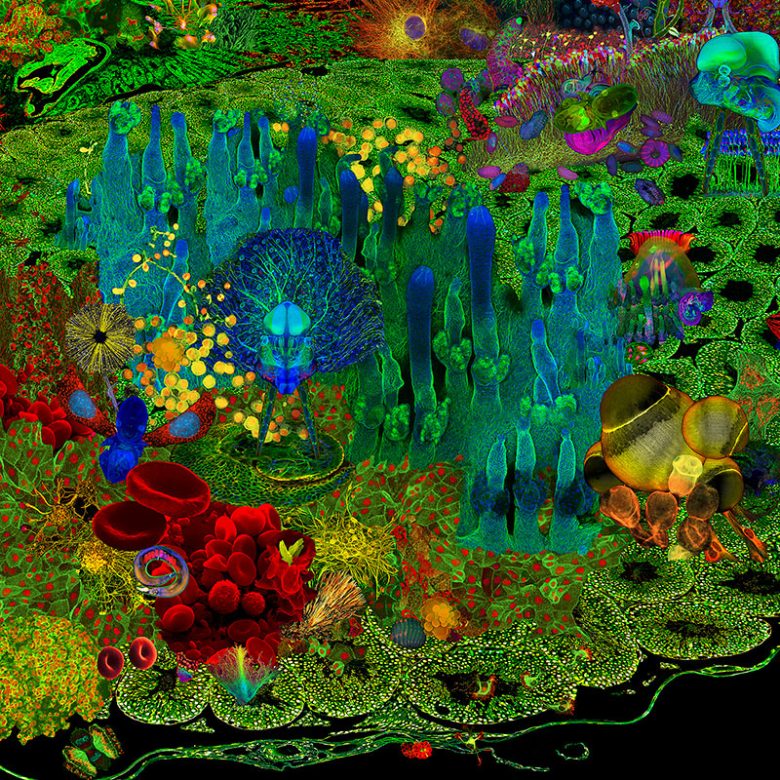
The artist from Barcelona had in mind to expand it. She planned to present two other parts, The Creation and The Inferno, with the same technique as her Paradise.
Unfortunately, she couldn’t, due to technical problems. The artist does not lose hope and she plans to exhibit it next summer.
Anna Rierola (Barcelona, 1969) is fascinated by science and research, as tools to show a unifying vision of an interconnected cyber world. She was the first resident artist at IRB Barcelona, where her Garden began to take shape.
For her work, Anna Rierola uses scientific images obtained with a microscope in research projects. She had the opportunity to talk with researchers from different departments about order and chaos, in the field of molecular biology.
Her work has been exhibited at Pirelli Hangar Bicocca for the Veronese Foundation in Milan. In 2019 she completed a 60-meter, permanent work on the façade of the Institute of Marine Sciences in the Barceloneta neighborhood. Currently, her work is part of the collective exhibition Ecosistemes de l’ inesperat at the Centro Arts Santa Mónica (both in Barcelona).
Gardens in Madrid
In 2001 we had the privilege of seeing other very original Gardens of Delights in the warehouses of Matadero in Madrid. It was a journey through the SOLO Collection, an invitation to rethink and connect from the contemporary with the Renaissance work of Hieronymus Bosch.
Artificial intelligence, sound art, 3D animation, painting, sculpture and installation accompanied the astonished spectators, in dialogue with the universal values that the work has maintained throughout history.
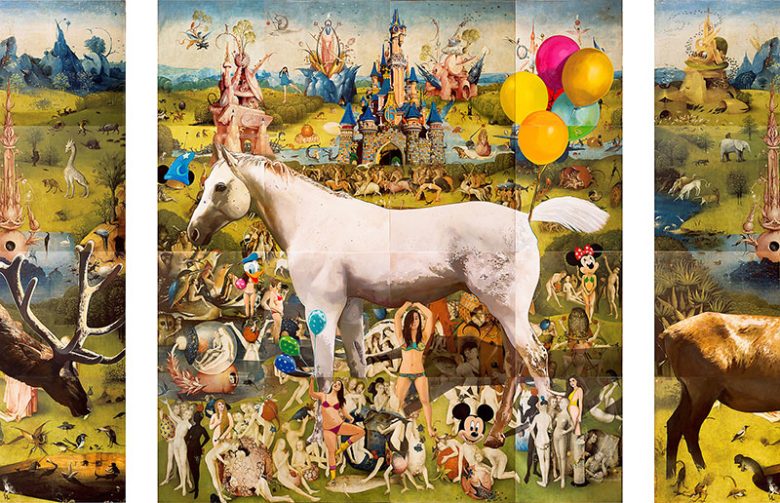
The exhibition brought together twenty international artists. Each one giving their personal touch, with new works based on the Renaissance triptych, using the latest in futuristic technology, artificial intelligence and even video games.
A new look at 16th century Flemish work, reinvented by contemporary artists: SMACK, Mario Klingemann, Miao Xiaochun, Cassie McQuater, Filip Custic, Lusesita, La Fura dels Baus- Carlus Padrissa, Mu Pan, Dan Hernández, Cool 3D World, Sholim, Dustin Yellin, Enrique del Castillo, Dave Cooper and Davor Gromilovic.
The 20 works are part of the futuristic SOLO Collection, an international project to support contemporary creation based
in Puerta de Alcalá, Madrid. The different evocations and visionary reinterpretations form an exhibition experience designed architecturally by the Estudio Herreros.
Both shows (Menorca and Madrid) offer us a reflection linked to the universal values that Hieronymus Bosch’s original painting has maintained throughout history.
We discover the constructive richness and the inexhaustible layers of interpretation of the original triptych, its symbolic potential and its ability to achieve a social portrait transferred to our time.
Another more modest example, also recreating the Garden of Earthly Delights, is a painting by Clara Gomez Campos (Cordoba, 1990). It shows a large white horse in the central panel and various allusions to Disneyland.
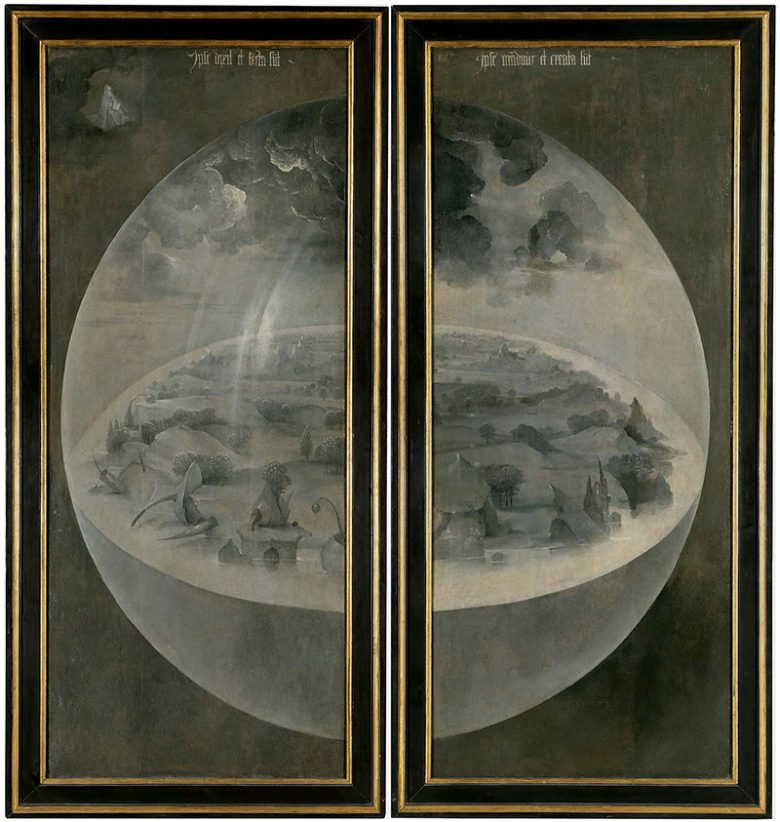
Original Garden of The Bosco
The painting that has inspired these contemporary artists is one of the masterful works of the Northern European Renaissance, by the great Flemish master, Jerónimos Bosch, known as Hieronymus Bosch. This is his masterpiece and is in the Prado Museum.
A triptych is a work that consists of three pieces, a central one and two lateral ones, which usually close over the central one. The Garden of Earthly Delights is actually the central panel of the triptych.
It is the most enigmatic of the three. It shows a large number of young people, naked, alone, in couples or in groups, carrying out different activities related to worldly pleasures: games, food, conversation and eroticism.
The left panel shows the creation in Paradise. God appears, in the figure of Christ, presenting Eve, (newly created) to Adam. The right panel is a version of hell with numerous musical instruments, known as Musical Hell, Closing over the central panel, the reverse of the side panels forms a monochrome painting (grisaille) whose theme is the third day of creation when God divided the earth from the waters and separated the elements, according to the Bible.
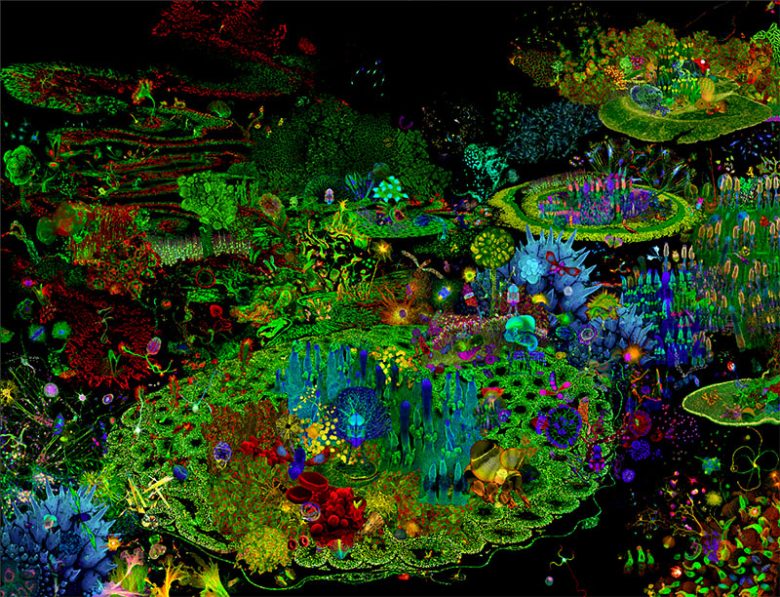
Hieronymus Bosch’s work is smaller than those of contemporary artists, in large format. That of the Flemish Renaissance measures 186 cm high, 77 cm. the side panels and 173 cm. the center panel. The technique is oil painting and grisaille on panel.
2016 was the year of Hieronymus Bosch, celebrating the 5th centenary of his death. The Prado Museum organised the largest exhibition in its history, sponsored by the BBVA Foundation, and premiered a documentary about the most enigmatic work of the brilliant medieval painter.
Surely there are other versions of the famous and bizarre Garden of Earthly Delights, created in the 16th century by Hieronymus Hieronymus. His pre- surreal triptych, magical and terrifying, has been and will be reinvented by artists of today and tomorrow.
For now, we are left with the intrigue of knowing the two pending works, a continuation of Anna Rierola’s recent exhibition in Menorca. The history of art is as fascinating as it is inexhaustible.
